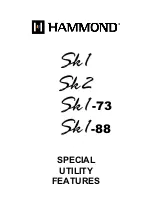
NORD ELECTRO 2 V2.0x
9. History: The story behind the Electro 2 instruments
Page 55
In 1959, Harold met a man named Leo Fender and
they decided to do something together. Leo had devel-
oped the Fender Stratocaster electric guitar and had a
great knowledge of amplifying strings. Together these
two gentlemen could develop a great electric piano.
Unfortunately, it seems they couldn't cooperate in the
way Harold wanted because Leo didn't like the sound
of the treble tines. As a result, between 1959 and 1965,
they released only one model, a 32-note bass version
called Piano Bass. Nevertheless, during this period Ha-
rold continued to develop his ideas further and con-
structed an 88-note electronic piano.
In January 1965, the large corporation CBS bought the
Fender Company and, as a result, Harold Rhodes final-
ly got the opportunity to put his newly designed instru-
ment into serious production. The model is called the Fender Rhodes Suitcase 73, where the "73" stands
for the number of keys on the piano. This model had a built-in pre-amp, amplifier, and speakers. Al-
though Leo Fender was no longer a part of the company, CBS decided to use both of the gentlemen's
names in conjunction with the product, supposedly for marketing reasons. Fender was a big name at the
time - and still is. Interestingly enough, Fender actually joined the company later on again for a period
of time, and it seems Harold and Leo together developed a new tone generator for the Fender Rhodes
electric piano. As a result, they filed a joint patent on August 4, 1970.
The Fender Rhodes Suitcase 73 was a hit on the market. Harold continued to refine his ideas, and every
year he improved the piano mechanically. After five years, the time came for a new model. It was called
the Fender Rhodes Mark 1 Stage piano. While it featured several hardware improvements, this instru-
ment lacked the built-in amplifier and speakers of the Suitcase model. The target group was, of course,
touring bands who demanded a more lightweight keyboard. While the Mark 1 Stage piano had only a
line-level output and a Bass EQ knob, the Suitcase model sported a "Vibrato" knob for controlling the
stereo effect that Harold had developed. In truth, "Vibrato" wasn't the correct word, as the effect was
really tremolo -- an amplitude modulation effect.
From 1970 to 1979, CBS released two electric pianos: the
Mark I and the flat-topped Mark II. It was during this pe-
riod that CBS decided to drop "Fender" from the logo and
use only the Rhodes name. In 1980, the Rhodes 54 hit the
market, yet another attempt to fill the needs of touring mu-
sicians in search of a more compact and lightweight key-
board. The last Rhodes developed during the CBS era was
the Mark III, which contained a built-in two-voice synthe-
sizer(!). It was not a success. In 1983, Rhodes was sold to
William Schultz and Harold designed the Rhodes Mark V
with the help of Steve Woodyard. Harold himself consid-
ered the Mark V the ultimate electric piano. It took Harold
25 years to get to this point. Something like 5,000 units of
the Mark V had been built and, two years after its launch,
the factory closed down. After this there were no more elec-
tromechanical Rhodes developed for the market. Harold
Rhodes died on December 17, 2000.
A Rhodes Suitcase 73 Mark I. The Suitcase models
feature built-in speakers facing the audience.
A Rhodes Stage Piano Mark II. The top was cut
down to make a flat top, perfectly amenable to sup-
porting another keyboard.














































